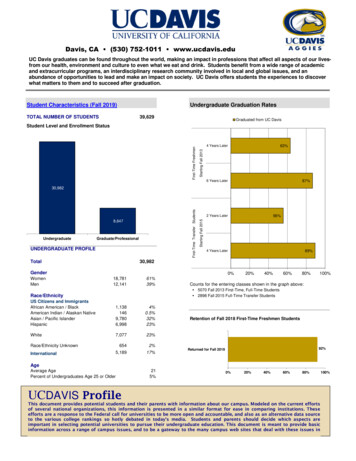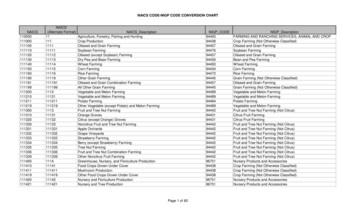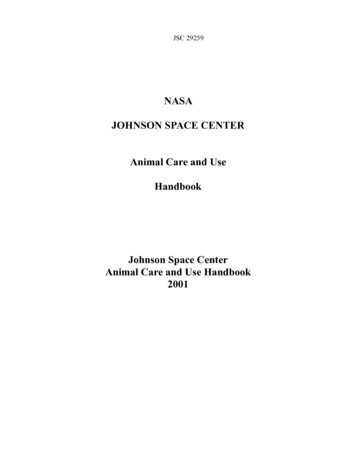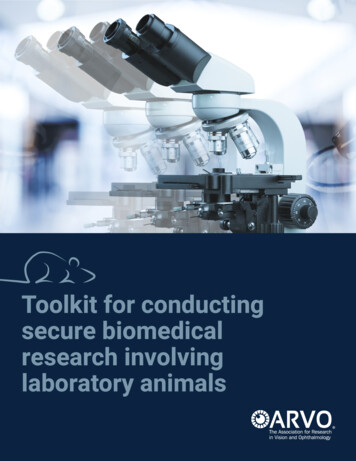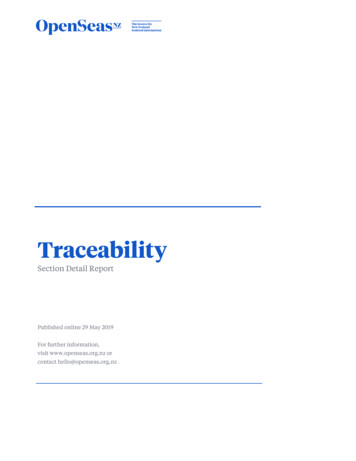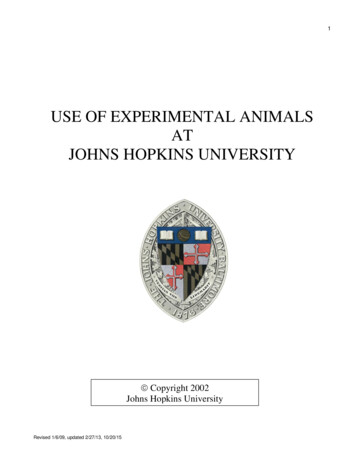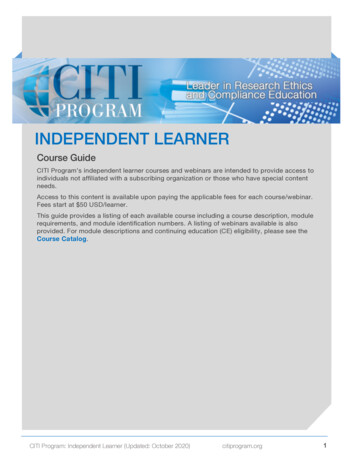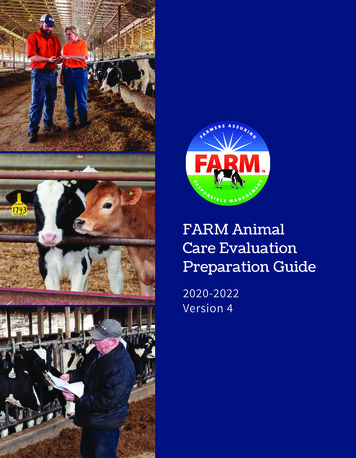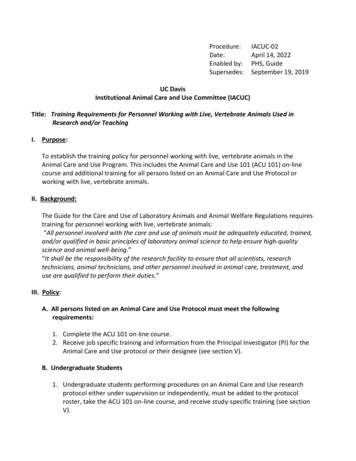
Transcription
Procedure:Date:Enabled by:Supersedes:IACUC-02April 14, 2022PHS, GuideSeptember 19, 2019UC DavisInstitutional Animal Care and Use Committee (IACUC)Title: Training Requirements for Personnel Working with Live, Vertebrate Animals Used inResearch and/or TeachingI. Purpose:To establish the training policy for personnel working with live, vertebrate animals in theAnimal Care and Use Program. This includes the Animal Care and Use 101 (ACU 101) on-linecourse and additional training for all persons listed on an Animal Care and Use Protocol orworking with live, vertebrate animals.II. Background:The Guide for the Care and Use of Laboratory Animals and Animal Welfare Regulations requirestraining for personnel working with live, vertebrate animals:“All personnel involved with the care and use of animals must be adequately educated, trained,and/or qualified in basic principles of laboratory animal science to help ensure high-qualityscience and animal well-being.”“It shall be the responsibility of the research facility to ensure that all scientists, researchtechnicians, animal technicians, and other personnel involved in animal care, treatment, anduse are qualified to perform their duties.”III. Policy:A. All persons listed on an Animal Care and Use Protocol must meet the followingrequirements:1. Complete the ACU 101 on-line course.2. Receive job specific training and information from the Principal Investigator (PI) for theAnimal Care and Use protocol or their designee (see section V).B. Undergraduate Students1. Undergraduate students performing procedures on an Animal Care and Use researchprotocol either under supervision or independently, must be added to the protocolroster, take the ACU 101 on-line course, and receive study-specific training (see sectionV).
2. Undergraduate students in courses involving animals covered by a teaching protocolmust be provided the Information for Students in Classes.C. Re-training:1. All personnel listed on an Animal Care and Use protocol must take the UC Davis IACUCThree-Year Re-training Exam OR complete the ACU 101 on-line course every threeyears.2. Re-training notifications are sent to individuals and the PI beginning at 90 days prior tothe individual’s training anniversary date. Notifications will continue to be sent every 30days until the Three-Year Re-training Exam or ACU 101 on-line course has beencompleted.3. If the Three-Year Re-training Exam OR the ACU 101 on-line course has not beencompleted by the individual’s training anniversary date, notification will be sent to theindividual and PI indicating removal from the Animal Care and Use Protocol roster. Oncere-training has been verified, the individual’s privilege to conduct research will bereinstated after an amendment to add the individual onto the protocol has beenreceived. If the PI has not completed the ACU 101 re-training, their protocol(s) may besuspended until the re-training has been completed.IV. Procedures:A. Campus/IACUC Office Responsibilities:1. Information Disseminationa. The ACU 101 course includes information on: Laws and regulations pertinent to animal care and use. The UC Davis Animal Care and Use Program for teaching and researchanimals. The Occupational Health Program for individuals working with animals.b. The IACUC Office ensures that the ACU 101 on-line course is available to allindividuals listed on an Animal Care and Use Protocol. The ACU 101 on-linecourse is hosted by the campus Learning Manangment System and a link isavailable on the Office of Research website. Attendees can access and print their certificate of completion on theLearning Management System (LMS.ucdavis.edu).c. The IACUC Office will inform PIs of any new policy, guidelines, or changes relatedto the care and use of animals.d. Certificates for the completion of the 3 year re-training exam are maintained onthe IACUC website and are available on request.2. Required Animal Care and Use Training
a. Information on the experience and training of each individual listed on aprotocol roster must be provided in the Animal Care and Use Protocol. Individualqualifications are reviewed and approved by the IACUC staff. The informationprovided must be specific to the procedures and species listed on the protocoland should be updated as necessary to reflect additional training/skills.b. The IACUC Office will provide guidance to PIs in developing trainingdocumentation.c. The IACUC will inspect PI’s training programs during laboratory inspections, postapproval monitoring, and/or facility inspections to verify that personnel havereceived required training. These inspections will take place and be performed inaccordance with the IACUC Inspection Program.d. All individuals performing survival surgery on laboratory animals must be trainedin aseptic technique in addition to the specific surgery techniques needed fortheir study.e. All personnel performing rodent survival surgery must take the on-line RodentSurvival Surgery course.f. All personnel performing physical methods of euthanasia on adult animalswithout anesthesia (i.e., cervical dislocation or decapitation) must be trained onthe technique and certified by one of the approved campus trainers.g. The IACUC may mandate additional training, including species-specific trainingfor individuals or a group of individuals, if: During the initial protocol review process, the need for additional trainingis identified. The procedure in the protocol changes substantially (e.g. changing fromterminal to survival surgery). Violations of the Animal Care and Use Protocol are identified due to lackof understanding of procedures or insufficient training.h. Species-specific training modules will be provided depending on need or at thediscretion of the IACUC or Attending Veterinarian. At a minimum, the followingcourses will be offered: Rat Handling and Lab Skills. Mouse Handling and Lab Skills. Rabbit Handling and Lab Skills. Rodent Aseptic Technique.i. The Office of the Attending Veterinarian will provide additional training asneeded.V. Principal Investigator’s Training Responsibilities for Animal Care and Use1. The PI is defined as the person on an IACUC protocol who has assumed the responsiblyfor all of the staff listed on the roster and the animals that are assigned under theprotocol. The PI on a protocol must have a career appointment with UC Davis. The PIshould be a faculty member, facility manager, or staff member. They must ensure that
appropriate training is provided and documented for everyone listed on their AnimalCare and Use Protocol before they work with live, vertebrate animals. Training must beprovided and documented for staff, volunteers, students, or visitors that work with live,vertebrate animals in teaching and/or research or when providing husbandry care.Training forms must be kept for three years after the person leaves the university.Some training may be performed annually.The PI must also ensure that everyone listed on their protocol participates in theOccupational Health Program according to IACUC policy Animal Care and UseOccupational Health Program.Exception: Temporary Affiliates (TAFs) – TAFs may use the exemption form in lieu ofenrolling in the Occupational Health Program if they are working with the same speciesat their home institution. In addition, each person listed on the Animal Care and UseProtocol must complete the ACU 101 course.The PI must ensure that everyone listed on their Animal Care and Use Protocol hasread the protocol and understands their responsibilities in relation to the protocol.Everyone working with live, vertebrate animals must be qualified to work withanimals, informed of their responsibilities, and trained in the specific proceduresdescribed in the protocol and/or otherwise required by the IACUC.2. In-house Training:The PI must provide training on the following: Protocol specific training: Training on procedures and techniques listed in theprotocol. Personal hygiene: How to reduce the risk of contamination to the person as wellas surfaces, other personnel, and other animals. Personal protective equipment: How to properly select and use personalprotective equipment such as gloves, eyewear, lab coats, and respirators. Use of the Hazard Analysis Tool: How to use the on-line Risk Analysis Tool. Animal bite instructions: How to appropriately respond to an animal bite,scratch, or similar exposure, including immediate washing and first aidprocedures, who to contact, and to whom to report the exposure. Thisinformation must be posted in the laboratory or work area. First Aid Proceduresfor Bites is available on the Occupational Health website. Allergies and Zoonotic diseases: Inform individuals of allergens or zoonoticdiseases associated with the species they are working with. The on-line RiskAnalysis Tool or “Zoonosis Information by Species” can be used for thisinstruction. Animal care and husbandry: Awareness of welfare procedures necessary foranimal care and husbandry. This is generally for animal care staff andinvestigator maintained animals only.
Euthanasia: Procedures on the euthanasia method approved in the Animal Careand Use Protocol.Pain and discomfort, anesthetics and analgesics: How to recognize the signs ofpain and discomfort in the species with which each individual will be workingand the use of the anesthetics and analgesics approved in the Animal Care andUse Protocol.Record keeping, monitoring procedures: How to maintain the necessary recordsand the monitoring procedures for each project (i.e., post-op monitoringrecords).Information contained in and purpose of the Injury and Illness PreventionProgram: Inform all personnel on the information contained in the Injury andIllness Prevention Program, such as how to read Safety Data Sheets, theevacuation plan, and the availability of pertinent Safety Services SafetyNets. TheInjury and Illness Prevention Program is revised every year and each person mustbe trained on the revision.Bloodborne pathogens: How to take the necessary precautions when workingwith bloodborne pathogens and what procedures to follow when a possiblecontamination has occurred.Other hazardous materials: Information regarding other hazardous substancessuch as chemicals and radiation used within the work area. This may include thesafety data sheets, personal protection, and other pertinent safety information.How to report an animal concern: As covered by the IACUC policy on Reports ofAnimal Care and Use Concerns.3. Documentation:Documentation of the above information must be maintained by the PI or designee andbe readily accessible to the IACUC staff or other site inspectors (i.e., Cal OSHA, AAALAC)during area inspections. The training document must include: Name of person(s) conducting training (who has been approved by the IACUC). Signature of person receiving training. Date of training. A brief description of subjects covered.The Individual Training Record can be used as a guide to assure all training has beendocumented and acknowledged by the PI and employee/student/temporaryaffiliate/volunteer. Each item on the training record should be individually initialed anddated.4. Available Resources:The IACUC provides the ACU 101 on-line course as well as assistance with other trainingneeds. For more information, please contact iacuc-staff@ucdavis.edu or 530-752-2364.
The IACUC office provides classes for species-specific animal handling and techniques,anesthesia, euthanasia methods, and aseptic surgical techniques. For information,contact iacuc-staff@ucdavis.edu or 530-752-2364. View class information hereUC Davis subscribes to the American Association for Laboratory Animal Science (AALAS)Learning Library. The AALAS library offers a wide variety of on-line training courses.Courses include training for the AALAS certification exams (ALAT, LAT, LATG), ContinuingEducation Units (CEUs) for AALAS certification renewals, training on techniques forworking with a variety of species, and regulatory training. Some of the courses arewithin the Registry of Approved Continuing Education (RACE) program for RegisteredVeterinary Technicians (RVTs) needing CEU’s to renew their license. A complete list ofcourses is available at https://www.aalaslearninglibrary.org/. We encourage all to takeadvantage of these training opportunities. If you would like access to these courses,please contact the IACUC Office (iacuc-staff@ucdavis.edu) to obtain a login ID andpassword.VI. Resources:1. ILAR, Guide for the Care and Use of Laboratory Animalshttp://nap.edu/129102. PHS y.htm3. UC Davis Occupational Health Surveillance System upational-health/surveillance-system4. UC Davis Safety Serviceshttps://safetyservices.ucdavis.edu/5. UC Davis Zoonotic Diseases and Risk iseases6. IACUC Risk Analysis Toolhttps://iacuc.ucdavis.edu/iacuc public/risktool/index.cfm7. Students in Classes ce/animal-care-use/iacuc/students-inclasses/8. IACUC Training liance/animal-care-use/training-classes/9. Reports of Animal Care and Use loads/IACUC-14.pdf10. Animal Care and Use Individual Training ads/training-record-2021.docx11. TAF Exemption s/Attch-2-TAF-Exemption-Form2022.pdf12. AALAS Learning Libraryhttps://www.aalaslearninglibrary.org/
Care and Use Program. This includes the Animal Care and Use 101 (ACU 101) on-line course and additional training for all persons listed on an Animal Care and Use (ACU) Protocol or working with live, vertebrate animals. II. Background: The Guide for the Care and Use of Laboratory Animals and Animal Welfare Regulations
